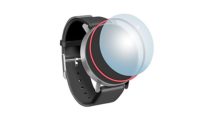Polyolefins, such as polypropylene and polyethylene, have always been tough to bond with adhesives. These plastics have such little surface energy that adhesives bead up on their surfaces like water on a freshly waxed car.
Materials with high surface energy allow liquids to spread out across their surfaces. Common plastics, such as ABS or polycarbonate, have a high have a high surface energy of 40 to 50 dynes per square centimeter. In contrast, polyolefins have a surface energy of just 20 to 30 dynes per square centimeter.
That’s a problem. If the adhesive cannot adequately wet the surface to get a grip, whether chemical or mechanical, the bond will be weak.
“You need good surface contact between the adhesive and the substrate,” says Dan Shaw, technology manager for structural adhesives at Henkel Corp. “You want intimate molecular contact. With a large difference in surface energy, you don’t get that contact, so adhesion will be much weaker and less robust.”
To increase the surface energy of polyolefins, engineers have typically relied on various surface treatments. These include primers, etching and energy treatment.
Primers chemically activate the surface of the plastic.
Etching, or surface roughening, doesn’t do much to raise the surface energy of the material. It simply provides more surface area for the adhesive to grip and adds a mechanical component to the bond.
With energy treatment, the plastic is exposed to a plasma, corona or flame for a short period of time. These processes improve bondability in several ways. They remove grease and other contaminants that inhibit adhesion. They etch the surface of the plastic at a microscopic level, which improves the bond’s mechanical strength. And, they chemically activate the surface of the plastic, making it more wettable and more likely to react with the adhesive.
The problem with all these methods is that they add time and cost to the assembly process. Energy treatment, in particular, can be expensive, and its effects are temporary. If the parts are not bonded within a short time after treatment, the plastic will eventually revert to its original low-energy state.
A New Adhesive
Henkel has just released a new adhesive, Loctite 3035 Polyolefin Bonder, that bonds low surface energy plastics without the need for primers or surface treatments. This two-part structural acrylic adhesive bonds to a wide range of materials, including high-density polyethylene (HDPE) and low-density polyethylene (LDPE), polypropylene, ABS, nylon, Teflon, polycarbonate, polyvinyl chloride (PVC), epoxy, steel and aluminum.
Pale yellow in color, the adhesive cures at room temperature, achieving fixture strength in 10 to 15 minutes. Full cure takes 24 hours. It has a work life of two to four minutes.
For ease of application, the adhesive is mixed at a ratio of 1-to-1. Producing a formulation with a simple mix ratio was a key goal in the development process for the adhesive, says Michael K. Williams, OEM market manager for Henkel.
“With a high mix ratio, if there’s something wrong with the cartridge, and the mix is off a little bit, the adhesive may not cure completely,” he explains. “With a 1-to-1 mix ratio, if the mix is off a little bit, it’s not as critical.”
The adhesive does not require refrigeration and has a one-year shelf-life. It is available in 50- and 400-milliliter dual cartridges. Package size was another reason Henkel wanted the adhesive to have a 1-to-1 mix ratio.
“Problems associated with large mix ratios tend to be amplified with smaller package sizes,” adds Shaw. “You just don’t have the volume of activator.”
Part A has a viscosity of 7,500 centipoise. Part B has a viscosity of 60,000 centipoise.
“Because the viscosity is low, it can be dispensed with either pneumatic or manual applicators,” says Williams.
On HDPE, Loctite 3035 produces bonds with a shear strength of 1,658 psi. On LDPE, it produces bonds with a shear strength of 632 psi. It bonds to PVC with a shear strength of 1,237 psi, and it bonds to metals with a shear strength of 400 to 650 psi.
Environmental tests are ongoing, but like most two-part structural acrylics, the new adhesive is expected to have very good resistance to moisture, salt fog and nonpolar solvents, such as diesel, gasoline and motor oil.
“Our initial testing backs that up, but the full battery of testing is not yet complete,” says Shaw.
When fully cured, the adhesive exhibits some flexibility. “We can’t quantify the flexibility right now but it’s not a rigid thermoset resin, like an epoxy,” explains Williams. “Being slightly flexible gives the adhesive very good impact resistance.”
Applications for the adhesive include plastic pipes, appliances, all-terrain vehicles, outdoor power equipment, outdoor furniture, toys, personal watercraft, buoys, and plastic storage tanks for automotive fluids.
For more information, call Henkel at 800-LOCTITE or visit their website.




